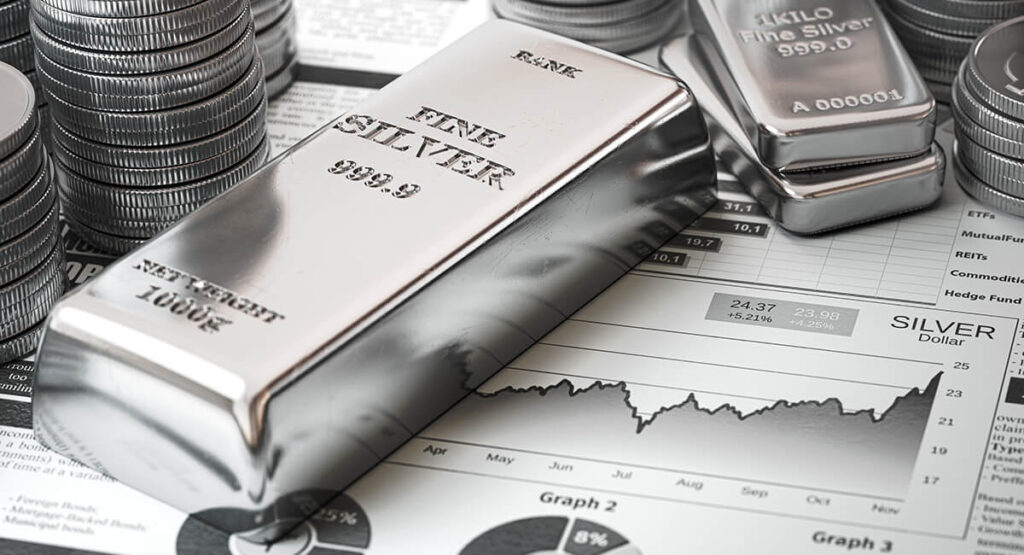Navigate
Article List
- Editorial
By Albert Cheng, CEO, SBMA
- SBMA News
By Albert Cheng, CEO, SBMA
- India’s Surge in Gold Imports: Optimism or Speculation?
By Srivatsava Ganapathy, CEO, Eventell Global Advisory
- India to See Strong Uptick in Jewellery Demand
By Chirag Sheth, Principal Consultant, Metals Focus
- Renminbi Internationalisation and its Effects on Gold
By Chinese Gold and Silver Exchange
- Thailand’s Gold Market: An Introduction
By SBMA, with contributions by Ross Andrew Friedman
- Thailand’s Crucial Role in the ASEAN Gold Market
By Nuttapong Hirunyasiri, CEO, MTS Gold Group
- Thailand: Gold Provides Liquidity Amid Pandemic
By Pawan Nawawattanasub, CEO, YLG Bullion International
- #SilverSqueeze – What Actually Happened and Why it Didn’t Work Out as Planned
By Brian Lan, Managing Director, GoldSilver Central
- Japan Exchange Group: Reinventing Japan’s Precious Metals Derivatives Market
By Ryoichi Seki, General Manager, Business Development, Osaka Exchange
- Gold Investing in a Digital World
By Kerry Stevenson, Founder, Gold & Alternative Investments Conference
Article List
- Editorial
By Albert Cheng, CEO, SBMA
- SBMA News
By Albert Cheng, CEO, SBMA
- India’s Surge in Gold Imports: Optimism or Speculation?
By Srivatsava Ganapathy, CEO, Eventell Global Advisory
- India to See Strong Uptick in Jewellery Demand
By Chirag Sheth, Principal Consultant, Metals Focus
- Renminbi Internationalisation and its Effects on Gold
By Chinese Gold and Silver Exchange
- Thailand’s Gold Market: An Introduction
By SBMA, with contributions by Ross Andrew Friedman
- Thailand’s Crucial Role in the ASEAN Gold Market
By Nuttapong Hirunyasiri, CEO, MTS Gold Group
- Thailand: Gold Provides Liquidity Amid Pandemic
By Pawan Nawawattanasub, CEO, YLG Bullion International
- #SilverSqueeze – What Actually Happened and Why it Didn’t Work Out as Planned
By Brian Lan, Managing Director, GoldSilver Central
- Japan Exchange Group: Reinventing Japan’s Precious Metals Derivatives Market
By Ryoichi Seki, General Manager, Business Development, Osaka Exchange
- Gold Investing in a Digital World
By Kerry Stevenson, Founder, Gold & Alternative Investments Conference
#SilverSqueeze – What Actually Happened and Why it Didn’t Work Out as Planned
By Brian Lan, Managing Director, GoldSilver Central
Published on April 10, 2021


BRIAN LAN is the Managing Director of GoldSilver Central and a member of the company’s Board of Directors. He is part of the team in charge of overall management of the company and is responsible for sales, operational infrastructure and predominantly, global business development. His passion is using technology to transform business processes and advance client outcomes. He also sits on the board of GoldPlus Assets and Fund Express.
Brian Lan looks at why a short squeeze didn’t work on silver and some of the questions posed by GoldSilver Central clients after the “Silver Squeeze”.
Many observers have heard about the Reddit group that recently spurred on many retail investors to short squeeze stocks that hedge funds have big short positions in. The idea is to drive prices of the stock high enough to force the hand of these hedge funds to buy back the stocks they have borrowed to sell, at a loss. It was reported that silver was also the target of a short squeeze after the success they had with GameStop and AMC shares.
WHY DIDN’T THIS WORK WITH THE SILVER MARKET?
The commodities market doesn’t work like the stock market. The shorts reported by the Chicago Mercantile Exchange (CME) or Commitment of Traders Report (COTR) does not mean that all of these shorts are speculative positions or positions that traders have placed to bet that prices will go south for them to make a profit. Refer to Table 1 for the COTR for silver (this data is readily available to anyone). At a glance, using the same lenses as how the Reddit retail investors view heavily shorted stocks, silver would seem like a prime candidate for a short squeeze for both commercial and non-commercial positions. For example, based on the short positions reported on 9 February for commercials, total short positions is 116,717 contracts. Note that each contract is for 5,000 oz. of silver.
Most of these short future positions are in fact hedging against physical silver exposure or miners securing prices in future months to deliver mined silver. In other words, these short futures positions are being offset with physical silver held in their inventory.
Another point to note, we do not know what is on the trading book of each bank and they might have positions not pushed out to the market yet as they have taken on a sizable position. For example, a trader in a bank may have bought a large amount of silver from a fund but has yet to sell it out so as not to move the silver price too drastically. This ride up in silver prices allows them to hedge their risk at a much higher profit and due to the larger number of buyers available, also allows them to get out of their positions even earlier and at a tidy profit. This is contrary to the belief that the silver squeeze will hurt banks and funds like how the Reddit short squeeze in stocks resulted in huge losses for some hedge funds.
The bottom line is, we do not see the full picture from the reports provided from CME or COTR.
Table 1: Commitment of Traders Report

OUTLOOK FOR 2021
Platinum plays a key role in decarbonisation and the growth of green hydrogen. Material demand growth from this will be realised within 5 to 10 years. However, the interest of many investors, who had not previously considered platinum, has been piqued by this strategic underpin to its long-term demand. When these investors take a closer look, they will see platinum’s deep discount to gold and palladium and the cost effectiveness and low CO2 of the mild-hybrid diesel powertrain, which greatly enhance the likelihood of platinum investment demand growth.
Since the platinum and gold price lows of 19 March 2020, at US$599/oz. and US$1,474/oz. respectively, platinum has significantly outperformed gold, rising 55% versus gold’s rise of 33% by the end of August. With investment demand and platinum’s fundamental outlook up in 2020, this significantly enhances its attractiveness.
IS IT TRUE THAT FINANCIAL INSTITUTIONS RAISED MARGINS TO PREVENT SILVER PRICES FROM SOARING?
Margins were raised by 18% by Comex but this was not because the institutions wanted silver prices to stay low. Many brokers followed suit too as the positions they had with banks or trading houses required them to place more margins. Margins required for trades is a function of volatility. The higher the volatility, the higher the margins required. This is for risk management and also to protect the interests of investors. This will happen for any asset class, not only for silver. This often has been misconstrued by many to think that financial institutions did this on purpose for their own gains.
PHYSICAL SILVER PREMIUMS SHOT UP SHARPLY, DOES THIS MEAN THERE IS NOT ENOUGH PHYSICAL SILVER?
Physical silver premiums rose by at least 50% or more but it does not mean that physical silver is running out. The sudden sharp increase in physical demand from clients globally due to the silver squeeze, coupled with the Covid-19 measures implemented in mints and refineries, have led to a short-term tightness in physical silver bars and coins. There are still large silver bars available at many vaults around the world but they are not the preferred choice for retail investors. The current ready silver stock – what we term as ex-stock silver inventory – commands an even higher premium due to the influx of demand. Coupled with the need for most retail investors to take possession of their physical silver as soon as possible, the premium for physical silver in the short-term doesn’t look like it will abate.
We have tracked the premiums of ex-stock 100 oz. silver bars – one of the most popular denomination of silver bars purchased by our clients over the years (Figure 1). The highest premiums was from late April until June, which was when the Covid-19 pandemic had just started to spread globally and many countries had implemented measures to stem its spread, including widespread lockkdowns. The premium gradually eased over time as supply finally caught up with demand, up until the recent silver squeeze.
The manpower restrictions due to Covid-19 also meant that production schedules for finished silver products had to be extended, especially with the sudden surge in demand. We expect the premiums to ease once the backlog has been met, but this could take at least 3 months.
Figure 1: Premium for a 100 oz. silver bar

WHERE WILL SILVER PRICES GO FROM HERE?
Fundamentally, silver has been in a deficit since 2019, largely due to the increase in physical demand from retail investors and exchange traded products (ETP) investments. With reference to Table 2, year-on-year increase in physical investment was 12% and the increase in ETP investments was 47%. We expect this to continue well into 2021, especially with the recent spotlight on silver brought about by the silver squeeze.
Looking at our in-house technical indicators, silver, just like gold, has just entered into a bullish trend in the medium term, hence the next 3 to 5 years should be good years for precious metals. We expect silver to continue to outperform gold this year, just as it has done last year, during which gold grew 25% and silver was up 48%. If you are looking to invest into silver, remember to buy on dips!
Table 2: Silver supply and demand


BRIAN LAN is the Managing Director of GoldSilver Central and a member of the company’s Board of Directors. He is part of the team in charge of overall management of the company and is responsible for sales, operational infrastructure and predominantly, global business development. His passion is using technology to transform business processes and advance client outcomes. He also sits on the board of GoldPlus Assets and Fund Express.























